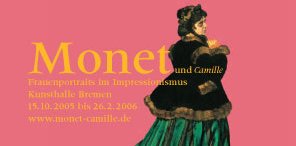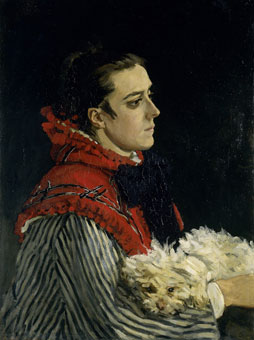Camille on her deathbed
The Influence of the Popular Media - Drawings,
Photography,and Fashion Illustrations.
For their full-body portraits of women, progressive painters
such as Monet, Manet and Renoir were
inspired by the popular pictorial world of their times.
Already in the nineteenth century, Paris was the center
of the international fashion world which became particularly inspiring for many painters. Around the middle of the century, the first large department stores were opened - true consumption temples of fashion -
and, for the first time, outstanding tailors were
celebrated as brilliant designers.
Numerous illustrated fashion magazines were
launched. In them, young artists found idealized figures
in intriguing poses which served to effectively show the
fashionable silhouettes of the dresses they were wearing.
By the 1860s, photographic portraits in the small carte
de visite format were very popular. Even for them, full-body representations were characteristic. Photography was still young in those days, and the painters were greatly interested in it; but, on the other hand, photographers also took over presentations, poses and attributes from
paintings.
The purpose of all of these media was to present fashionable clothes.
Soon after Monet, Renoir and Carolus Duran had exhibited portraits of their friends in the Salon, they received orders for representative paintings from the bourgeoisie.
Now they had to bring their artistic ambitions in line with
the ideas of their clients.
The three artists dealt with this task quite differently: in his
Portrait of Madame Gaudibert, Monet did paint a
representative interior, but he showed only a lost profile
of his model, so her face can hardly be recognized. That
way, he refused to go along with the main purpose of
bourgeois reminiscent paintings.
He soon gave up painting portraits altogether and became
a pure landscape painter.
Renoir, on the other hand, tried to balance his liberal artistic
style and the representative purpose of a portrait. In the
late 1870s, he created several paintings ordered by
collectors and intellectuals.
Carolus-Duran came closest to meeting the expectations
of his clients. His Portrait of Madame Feydeau is an
adaptation of Monet's Camille to the taste of a broad
public: his model turns her face towards the viewer, and
its individual lines have carefully been worked out. Even
her pose and the way her clothes are painted comply
with her representative demands. Hence, Carolus-Duran
became the favorite portraitist of the Parisian upper
middle classes.
8) Small-Format Variations - A Fashionable Genre in an
Impressionist Style
Full-body portraits of women were not only done in large
formats. Pierre-Auguste Renoir, Monet's close friend, transferred
the motif into smaller formats in the 1870s and incorporated
it in genre-type situations such as strolling, reading, or
taking care of pets. The compositions and the narrative
style of his paintings thus verged upon the popular
single-figure genre. At the same time, however,
he transformed this genre into an Impressionist style.
Here, too, the lines between genre and portrait are indistinct:
the painting Camille Monet Reading is an individual portrait,
but it shows the model in her domestic environment, doing something quite normal.
Despite his early success with Camille in the Green
Dress, Monet and his friends later kept being rejected
by the conservative jury of the Salon. 1874 was the first year in which they organised an independent exhibition
to show their works.
Here, Monet's painting Impression was also
shown, which made a critic disparagingly call the artists
"Impressionists".
Although they differed greatly in style,
the Impressionists were all interested in motifs taken
from modern life, and they all had a free, individual techniques. Today, the 1870s are considered the
prime years of Impressionism.
Camille acted as tireless model for Monet and many of
his friends, immortalized in these beautiful works.
(I love the brave Impressionists. Text from the 2006 exibition catalog-BBL)
| 





No comments:
Post a Comment